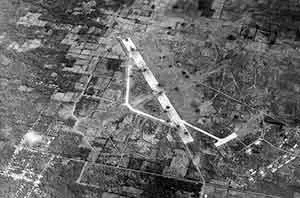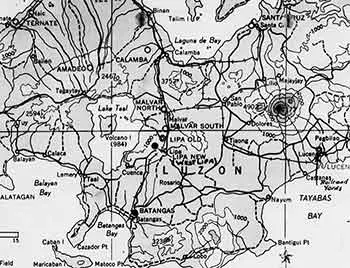[WWII] Attacks on Lipa and Batangas Airfields by Carrier-Based American Planes in November 1944
By November 1944, Allied Forces under the command of General Douglas MacArthur had already established a foothold on the island of Leyte and military planners were looking ahead to the eventual assault on the more heavily defended island of Luzon. While most of the ground forces required for the assault would come from the United States Army, naval forces under the command of Admiral Chester Nimitz were given the responsibility of “supporting the invasion of Luzon with carriers, surface combat vessels, and amphibious shipping1.”
The invasion of Luzon was premised on the establishment of “land-based aircraft at the southwestern corner of Mindoro... to provide air cover for the follow-up shipping and to increase the scale of air operations against Luzon2.” However, before a base for land-based aircraft could be set up on Mindoro, it was essential “to neutralize all Japanese fields within fighter and medium bomber range of the Mindoro beaches3.”
Among these fields were three located in Batangas — Batangas Airfield, Lipa Airfield, and Malvar Airfield.
Batangas Airfield was a single runway field jointly used by the United States Army Air Corps and the Philippine Army Air Corps before the war4 and subsequently taken over by the Japanese. The Lipa and Malvar Airfields, meanwhile, were hastily constructed by United States Army engineers in December 1941 and just as hastily abandoned when the order to retreat to Bataan was issued5. Both bases were taken over by the Japanese.
 |
| Bomb craters are visible on the runway of the Lipa Airfield after an American attack in 1945. Image credit: US National Archives. |
Because of the three airfields’ proximity to Mindoro, they were targeted for assault by American planes. One such assault was made on 19 November 1944 and documented in a now-declassified Air Action Report6. It was made by 15 F6-F “Hellcat” fighter aircraft composing Squadron VF-7 that took off from the carrier USS Hancock of Admiral William Frederick Halsey’s 3rd Fleet.
The 15 Hellcat fighters, commanded by a Lt. Commander Check, were given the mission of sweeping Lipa West Airfield7 and Batangas Airfield. The planes flew at 12,000 to 15,000 feet before swooping down on the assigned targets.
The action report described how the assault on the Lipa Airfield was carried out:
“Three divisions went down to attack first, followed by the fourth. On this attack, AA8 positions, dispersal areas9, and the carefully camouflaged shops to the SE of the airfield were chosen as targets. It was noted that the AA opposition was much lighter than on previous attacks on the field. One plane was destroyed, and one damaged in addition to whatever planes were caught by the fires and explosions which followed the bombing of the coconut grove which had been used for a dispersal area. Large fires were seen later as some of the planes flew over this field on returning from their second objective10.”
The assault on Batangas Airfield was not as productive. The action report noted that “targets were lacking,” although also noting that one building was blown up and smaller targets, including a steam roller for paving roads, were destroyed.
After assaulting Batangas Airfield, the fighter planes flew back north to Lipa Airfield to conduct strafing runs. A group broke off from the main attack force and flew to Malvar field — which was really close to Lipa from the air — where they attacked the barracks with rockets and machine guns.
Squadron leader Check’s plane developed engine trouble and had to retreat along with Check’s wing-man. On the way back to the carrier, the two planes attacked five light sailing ships and left these in flames. They also attacked the Lucena Railroad yards, destroying a railroad engine and inflicting damage on the yards.
The mission was not totally without loss — two aircraft of the squadron were destroyed. One crash-landed and was a total wreck. The other was hit by anti-aircraft fire at Batangas Airfield. Its pilot, one Lt. (jg) G.W. Reeves, bailed out but his parachute failed to open. He disappeared upon hitting the water presumably at Batangas Bay and was considered missing. The aircraft was reported as lost.
1 “The War in the Pacific: Triumph in the Philippines,” by Robert Ross Smith, published 1991 by the United States Army Center of Military History.
2 Ibid.
1 3 Ibid.
4 “Batangas Airfield,” publication date unknown, updated April 2021, online at Pacific Wrecks.
5 “They Fought with What They Had,” by Walter D. Edmonds, published 1951 by the Center for Air Force History, Washington D.C.
6 “Air Action Report: Sweep — West Lipa and Batangas Airfields,” dated 19 November 1944, online at the United States National Archives.
7 There were two airstrips in Lipa, documented as “east” and “west.” West was concrete, improved by the Japanese on the hastily abandoned US Army-built landing field. East was a sod or grass auxiliary airfield very close to the west airstrip and probably in Calingatan (a barrio of Mataasnakahoy) or San Salvador (a barrio of Lipa). The west airfield would subsequently become Basilio Fernando Air Base.
8 AA means anti-aircraft.
9 The term “dispersal” area refers to an area close to the runway utilized for parking airplanes in dispersed positions as protection from enemy attacks from the air.
10 Action report, op cit.

